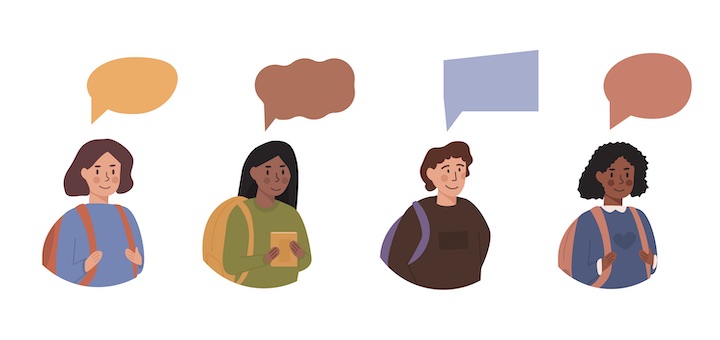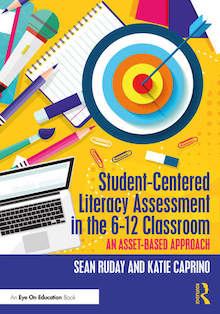Student Centered and Asset Based Assessment
By Sean Ruday and Katie Caprino

Sean Ruday
What do you think of when you think about assessment? What kinds of practices and activities come to mind? What is valued and emphasized in those practices?
Our answers to these questions have led us to think deeply about the concept of literacy assessment, such as the forms it has often taken and how it can be reimagined to be as inclusive and meaningful as possible.

Katie Caprino
While reflecting on these ideas, Sean said to himself that “Assessment shouldn’t be focused on what students don’t know. It should focus on what students can do with information and on authentic applications and connections.”
In other words, assessments should be opportunities for students to show what they do know in ways that capitalize on their strengths.
By using authentic and meaningful literacy assessments to help students display their knowledge of literacy concepts in relevant ways, teachers can take an asset-based approach to assessment. Instead of using assessments that focus on identifying what students don’t know, asset-based assessment practices provide opportunities for students to use what they do know to demonstrate their knowledge of important literacy concepts.
Asset-based assessment practices create opportunities for students to convey key understandings of literacy concepts in ways that are meaningful to them and align with their identities and interests. Teachers who implement these assessment practices decenter themselves while centering their students through opportunities for students to show what they know and can do in authentic and relevant ways.
For example, asset-based literature assessment can provide students with opportunities for them to reflect on key issues in a text that are relevant to them and construct multimodal artifacts (such as videos, infographics, presentations, websites, or audio files) through which they apply their understandings of those issues to real-world situations that are important to them.
Similarly, asset-based writing instruction assessment could ask students to write about issues related to communities with which they identify while creating opportunities for students to use linguistic forms and structures that are authentic to those communities.
In addition, asset-based language instruction can involve students looking for authentic examples of grammatical concepts in their out-of-school lives and conveying those ideas using methods that provide them with opportunities to communicate with real-world audiences through a range of formats.
These assessment forms – and others in a similar vein – can result in meaningful evaluations of student knowledge that incorporate authentic applications and students’ unique perspectives. By centering students through our literacy assessments, we can work toward instructional environments that facilitate success for our students – especially those who have traditionally not been well-served by our current education system.
In this blog post we provide six suggestions that we recommend using in order to begin the process of thinking about, creating, and utilizing asset-based assessment. Along with each suggestion we provide descriptions of what each one means and ideas for putting the suggestion into action.
Suggestion 1: Reflect on Issues of Equity in Assessment
Before you begin to design asset-based assessment opportunities for your students, we urge you to take some time and think about the concept of equity and its relationship to assessment.
To do so, we recommend responding to these three reflection prompts:
1. What do you think about when you reflect on equity in education?
2. What you think about when you reflect on assessment?
3. How do you feel the concepts of equity in education and assessment connect?
Sean reflected on these ideas before incorporating asset-based assessments with a ninth-grade English class he helped teach. Sean noted how much the assessments he experienced as a student were deficit-based and considered the ways he has worked to move away from this assessment approach and toward one that centers students and provides them with opportunities for ownership and application.
By engaging in these reflections, you’ll activate your prior knowledge on the concepts of equity and assessment and will ensure that you’ve thought carefully about these issues before constructing asset-based assessments.
Suggestion 2: Learn About Your Students’ Assets
In order to incorporate asset-based literacy assessments in our classrooms, it’s essential that we as teachers commit to learning about our students’ assets. Doing so provides us with essential understandings of students’ identities, cultures, interests, and experiences. This knowledge is essential to creating authentic and meaningful opportunities for students to demonstrate their understandings in ways that center their assets instead of their deficits. As you learn about your students’ assets, we recommend keeping these three suggestions in mind:
► Find out about your students’ assets early in the year through initial surveys and responses.
These can be questions about topics such as students’ interests, events and issues (in their communities and in society in general) that matter to them, the texts they engage with outside of school, the ways they enjoy communicating, and their preferred tools of communication.
This will not only help you learn about your students but will also communicate to them your interest in what matters to them, which will help create a student-centered environment in your classroom.
In addition to using surveys and response questions to learn about students, we strongly recommend that you create opportunities (whole class, small group, or peer to peer discussions, for example) to listen to and observe your students to find out about their assets, interests, identities, and experiences.
Doing this will help you learn more about topics that matter to your students as well as the modalities and texts that are authentic and relevant to who they are and what they value.
► Continue to learn about your students’ assets throughout the school year.
The process of learning about our students’ assets is fluid and ongoing. As we work with our students throughout the school year, it’s essential that we continuously identify, reflect on, and act on information related to their identities, assets, and interests. We can do this by continually learning from our conversations with them, the work they do on their assessments, and ideas they share in their written and oral responses.
Suggestion 3: Identify Your Curricular Goals
When constructing asset-based assessment opportunities for your students, we encourage you first to select a skill, strategy, or concept on which you want to evaluate your students’ knowledge. These may be concepts addressed in state or national standards, your school’s pacing guide, and other content that you feel students are ready to learn.
For example, you might identify key writing strategies, components of literary analysis, and/or grammatical concepts. After you identify this information, you’ll be well positioned to think about how to design assessments that provide students with ways to draw on their authentic interests, identities, and experiences while demonstrating knowledge of this topic.
Suggestion 4: Craft Opportunities for Students to Demonstrate Their Knowledge in Asset-Based Ways
Once you’ve identified the academic targets for your students to reach, you’re ready to put your understandings of these curricular goals and your students’ assets into action by creating student-centered assessment opportunities. As you do so, it’s essential to think about how much an effective asset-based assessment is aligned with a particular educational context.
In addition to the academic goals that you want your students to achieve, this context includes the issues and topics that matter to your students, their authentic, out-of-school literacy practices, the types of texts they like to create, the kinds of texts they consume, and the ways they communicate in their everyday lives.
All of these attributes combine to create the literacy context present in your classroom. For example, students in an English class with which Sean worked expressed a great deal of interest in social issues, multimodal expression, and community-related topics. With this in mind, Sean created an assessment for students’ analysis of their independent reading book in which students identified justice-oriented issues in the books they read and created written and multimedia proposals for community events.
It’s important to note that assessments and instructional practices that correspond with the features of one context do not necessarily align with another. Each year, you’ll want to identify the attributes and assets of that group of students and construct assessments that align with that educational context.
Suggestion 5: Support Your Students Through Their Work on Asset-Based Assessment
Asset-based assessments center our students and can greatly engage them in their academic work by drawing on their identities, experiences, and authentic literacy practices. However, this doesn’t mean that we can simply give students an engaging assignment and just leave them to their own devices. Instead, it’s essential that we teachers support and guide our students in ways that facilitate their understandings and successes as they work on these assessment projects. With this in mind, we’ve identified three ways to help students as they construct asset-based assessments:
► Support students as they master the academic concept.
► Model the assessment for the students.
► Individually confer with students as they work on their assessment products.
These practices will guide students and help them do their best possible work on their assessments.
Suggestion 6: Continuously Reflect on What You’ve Learned From Your Students’ Asset-Based Assessments and Make Adjustments Accordingly
Finally, we encourage you to continue to reflect on the process of asset-based assessment throughout the school year. For example, after each assessment, it’s important to think about what that experience showed you about your students, such as their identities, understandings, and assets, and how you can use that information to shape your future asset-based assessments.
We recommend taking some time after students complete each assessment to consider how they engaged with the assessment’s format and used it to convey their authentic ideas and interests. In addition, we suggest noting what the assessment revealed about students’ academic strengths and areas of need.
This knowledge will help you construct asset-based assessment opportunities that align with and are responsive to students’ attributes in ways that align with their identities with respect to modalities, interests, cultures, and academics.
Closing Points
We’d like to close with an important concept to keep in mind when constructing asset-based opportunities for our students to demonstrate their knowledge. Our students have rich ideas, perspectives, and experiences. The most effective assessments (and corresponding instructional activities) create opportunities for students to draw on those assets and use them to convey their understandings in meaningful and authentic ways.
When we incorporate assessments that honor students’ assets and identities, we take an essential step toward creating an inclusive classroom that values students’ cultures and centers them in their learning.

Katie Caprino is Assistant Professor of PK-12 New Literacies at Elizabethtown College and a former middle and high school English teacher. A trained reading specialist and instructional coach, her interests are in the areas of children’s, middle grades, and young adult literature; the teaching of writing; and technology-infused literacy education.
This post shares ideas found in the book Student-Centered Literacy Assessment in the 6-12 Classroom: An Asset-Based Approach, written by Sean Ruday and Katie Caprino and published by Routledge/Eye on Education (2022).



































